Ultra-Broadband Mid-Infrared Metamaterial Absorber Based on Multi-Sized Resonators
Abstract
:1. Introduction
2. Design and Simulation
3. Results and Discussion
4. Conclusions
Author Contributions
Funding
Institutional Review Board Statement
Informed Consent Statement
Data Availability Statement
Conflicts of Interest
References
- Pendry, J.B.; Holden, A.J.; Stewart, W.J.; Youngs, I. Extremely Low Frequency Plasmons in Metallic Mesostructures. Phys. Rev. Lett. 1996, 76, 4773–4776. [Google Scholar] [CrossRef] [PubMed] [Green Version]
- Pendry, J.B.; Holden, A.J.; Robbins, D.J.; Stewart, W.J. Magnetism from conductors and enhanced nonlinear phenomena. IEEE Trans. Microw. Theory Tech. 1999, 47, 2075–2084. [Google Scholar] [CrossRef] [Green Version]
- Shelby, R.A.; Smith, D.R.; Schultz, S. Experimental Verification of a Negative Index of Refraction. Science 2001, 292, 77–79. [Google Scholar] [CrossRef] [PubMed] [Green Version]
- Wu, J.; Xie, Z.T.; Sha, Y.; Fu, H.; Li, Q. Epsilon-near-zero photonics: Infinite potentials. Photonics Res. 2021, 9, 1616. [Google Scholar] [CrossRef]
- Ye, W.; Zeuner, F.; Li, X.; Reineke, B.; He, S.; Qiu, C.-W.; Liu, J.; Wang, Y.; Zhang, S.; Zentgraf, T. Spin and wavelength multiplexed nonlinear metasurface holography. Nat. Commun. 2016, 7, 11930. [Google Scholar] [CrossRef] [PubMed]
- Zheng, G.; Mühlenbernd, H.; Kenney, M.; Li, G.; Zentgraf, T.; Zhang, S. Metasurface holograms reaching 80% efficiency. Nat. Nanotechnol. 2015, 10, 308–312. [Google Scholar] [CrossRef] [PubMed]
- Iwaszczuk, K.; Strikwerda, A.; Fan, K.; Zhang, X.; Averitt, R.D.; Jepsen, P.U. Flexible metamaterial absorbers for stealth applications at terahertz frequencies. Opt. Express 2011, 20, 635–643. [Google Scholar] [CrossRef] [Green Version]
- Qian, C.; Zheng, B.; Shen, Y.; Jing, L.; Li, E.; Shen, L.; Chen, H. Deep-learning-enabled self-adaptive microwave cloak without human intervention. Nat. Photonics 2020, 14, 383–390. [Google Scholar] [CrossRef]
- Balci, O.; Polat, E.O.; Kakenov, N.; Kocabas, C. Graphene-enabled electrically switchable radar-absorbing surfaces. Nat. Commun. 2015, 6, 6628. [Google Scholar] [CrossRef] [Green Version]
- Yilmaz, H.O.; Yaman, F. Metamaterial Antenna Designs for a 5.8-GHz Doppler Radar. IEEE Trans. Instrum. Meas. 2020, 69, 1775–1782. [Google Scholar] [CrossRef]
- Freitag, M.; Low, T.; Zhu, W.; Yan, H.; Xia, F.; Avouris, P. Photocurrent in graphene harnessed by tunable intrinsic plasmons. Nat. Commun. 2013, 4, 1951. [Google Scholar] [CrossRef] [Green Version]
- Lio, G.E.; Ferraro, A.; Giocondo, M.; Caputo, R.; De Luca, A. Color Gamut Behavior in Epsilon Near-Zero Nanocavities during Propagation of Gap Surface Plasmons. Adv. Opt. Mater. 2020, 8, 2000487. [Google Scholar] [CrossRef]
- Lio, G.; Ferraro, A. LIDAR and Beam Steering Tailored by Neuromorphic Metasurfaces Dipped in a Tunable Surrounding Medium. Photonics 2021, 8, 65. [Google Scholar] [CrossRef]
- Landy, N.I.; Sajuyigbe, S.; Mock, J.J.; Smith, D.R.; Padilla, W.J. Perfect Metamaterial Absorber. Phys. Rev. Lett. 2008, 100, 207402. [Google Scholar] [CrossRef]
- Shen, X.; Cui, T.J.; Zhao, J.; Ma, H.F.; Jiang, W.X.; Li, H. Polarization-independent wide-angle triple-band metamaterial absorber. Opt. Express 2011, 19, 9401–9407. [Google Scholar] [CrossRef]
- Andryieuski, A.; Lavrinenko, A. Graphene metamaterials based tunable terahertz absorber: Effective surface conductivity approach. Opt. Express 2013, 21, 9144–9155. [Google Scholar] [CrossRef] [Green Version]
- Zhao, X.; Wang, Y.; Schalch, J.; Duan, G.; Cremin, K.; Zhang, J.; Chen, C.; Averitt, R.D.; Zhang, X. Optically Modulated Ultra-Broadband All-Silicon Metamaterial Terahertz Absorbers. ACS Photonics 2019, 6, 830–837. [Google Scholar] [CrossRef]
- Wang, B.-X.; Xu, C.; Duan, G.; Jiang, J.; Xu, W.; Yang, Z.; Wu, Y. Miniaturized and Actively Tunable Triple-Band Terahertz Metamaterial Absorber Using an Analogy I-Typed Resonator. Nanoscale Res. Lett. 2022, 17, 35. [Google Scholar] [CrossRef]
- McCrindle, I.J.H.; Grant, J.; Drysdale, T.D.; Cumming, D.R.S. Multi-Spectral Materials: Hybridisation of Optical Plasmonic Filters and a Terahertz Metamaterial Absorber. Adv. Opt. Mater. 2013, 2, 149–153. [Google Scholar] [CrossRef] [Green Version]
- Xu, H.; Hu, L.; Lu, Y.; Xu, J.; Chen, Y. Dual-Band Metamaterial Absorbers in the Visible and Near-Infrared Regions. J. Phys. Chem. C 2019, 123, 10028–10033. [Google Scholar] [CrossRef]
- Yang, J.; Qu, S.; Ma, H.; Wang, J.; Yang, S.; Pang, Y. Broadband infrared metamaterial absorber based on anodic aluminum oxide template. Opt. Laser Technol. 2018, 101, 177–182. [Google Scholar] [CrossRef]
- Jung, J.-Y.; Lee, J.; Choi, J.-H.; Choi, D.-G.; Jeong, J.-H. Enhancement of refractive index sensing for infrared plasmonic metamaterial absorber with nanogap. Opt. Express 2021, 29, 22796–22804. [Google Scholar] [CrossRef]
- Liu, J.; Ma, W.-Z.; Chen, W.; Yu, G.-X.; Chen, Y.-S.; Deng, X.-C.; Yang, C.-F. Numerical analysis of an ultra-wideband metamaterial absorber with high absorptivity from visible light to near-infrared. Opt. Express 2020, 28, 23748. [Google Scholar] [CrossRef] [PubMed]
- Baqir, M.A.; Choudhury, P.K. Hyperbolic Metamaterial-Based UV Absorber. IEEE Photonics Technol. Lett. 2017, 29, 1548–1551. [Google Scholar] [CrossRef]
- Liu, X.; Ren, Z.; Yang, T.; Chen, L.; Wang, Q.; Zhou, J. Tunable metamaterial absorber based on resonant strontium titanate artificial atoms. J. Mater. Sci. Technol. 2020, 62, 249–253. [Google Scholar] [CrossRef]
- Luo, Z.; Ji, S.; Zhao, J.; Wu, H.; Dai, H. A multiband metamaterial absorber for GHz and THz simultaneously. Results Phys. 2021, 30, 104893. [Google Scholar] [CrossRef]
- Tofigh, F.; Amiri, M.; Shariati, N.; Lipman, J.; Abolhasan, M. Polarization-Insensitive Metamaterial Absorber for Crowd Estimation Based on Electromagnetic Energy Measurements. IEEE Trans. Antennas Propag. 2019, 68, 1458–1467. [Google Scholar] [CrossRef]
- Qian, J.; Zhou, J.; Zhu, Z.; Ge, Z.; Wu, S.; Liu, X.; Yi, J. Polarization-Insensitive Broadband THz Absorber Based on Circular Graphene Patches. Nanomaterials 2021, 11, 2709. [Google Scholar] [CrossRef]
- Cheng, Y.Z.; Cheng, Z.Z.; Mao, X.S.; Gong, R.Z. Ultra-Thin Multi-Band Polarization-Insensitive Microwave Metamaterial Absorber Based on Multiple-Order Responses Using a Single Resonator Structure. Materials 2017, 10, 1241. [Google Scholar] [CrossRef] [Green Version]
- Huang, X.; Yang, H.; Shen, Z.; Chen, J.; Lin, H.; Yu, Z. Water-injected all-dielectric ultra-wideband and prominent oblique incidence metamaterial absorber in microwave regime. J. Phys. D Appl. Phys. 2017, 50, 385304. [Google Scholar] [CrossRef]
- Shabanpour, J.; Beyraghi, S.; Oraizi, H. Reconfigurable honeycomb metamaterial absorber having incident angular stability. Sci. Rep. 2020, 10, 14920. [Google Scholar] [CrossRef]
- Li, J.; Li, J.; Zhou, H.; Zhang, G.; Liu, H.; Wang, S.; Yi, F. Plasmonic metamaterial absorbers with strong coupling effects for small pixel infrared detectors. Opt. Express 2021, 29, 22907–22921. [Google Scholar] [CrossRef]
- Huang, X.; Cao, M.; Wang, D.; Li, X.; Fan, J.; Li, X. Broadband polarization-insensitive and oblique-incidence terahertz metamaterial absorber with multi-layered graphene. Opt. Mater. Express 2022, 12, 811. [Google Scholar] [CrossRef]
- Feng, R.; Qiu, J.; Liu, L.; Ding, W.; Chen, L. Parallel LC circuit model for multi-band absorption and preliminary design of radiative cooling. Opt. Express 2014, 22, A1713–A1724. [Google Scholar] [CrossRef]
- Zhou, Y.; Liang, Z.; Qin, Z.; Shi, X.; Meng, D.; Zhang, L. Results in Physics Broadband Long Wavelength Infrared Metamaterial Absorbers. Results Phys. 2020, 19, 103566. [Google Scholar] [CrossRef]
- Guo, W.; Liu, Y.; Han, T. Ultra-broadband infrared metasurface absorber. Opt. Express 2016, 24, 20586–20592. [Google Scholar] [CrossRef]
- Qin, Z.; Shi, X.; Yang, F.; Hou, E.; Meng, D.; Sun, C.; Dai, R.; Zhang, S.; Liu, H.; Xu, H.; et al. Multi-mode plasmonic resonance broadband LWIR metamaterial absorber based on lossy metal ring. Opt. Express 2021, 30, 473. [Google Scholar] [CrossRef]
- Zhou, Y.; Liang, Z.; Qin, Z.; Hou, E.; Shi, X.; Zhang, Y.; Xiong, Y.; Tang, Y.; Fan, Y.; Yang, F.; et al. Small-Sized Long Wavelength Infrared Absorber with Perfect Ultra-Broadband Absorptivity. Opt. Express 2020, 28, 1279–1290. [Google Scholar] [CrossRef]
- Wu, B.; Liu, Z.; Du, G.; Chen, Q.; Liu, X.; Fu, G.; Liu, G. Polarization and angle insensitive ultra-broadband mid-infrared perfect absorber. Phys. Lett. A 2020, 384, 126288. [Google Scholar] [CrossRef]
- Ozbay, I.; Ghobadi, A.; Butun, B.; Turhan-Sayan, G. Bismuth plasmonics for extraordinary light absorption in deep sub-wavelength geometries. Opt. Lett. 2020, 45, 686–689. [Google Scholar] [CrossRef]
- Tang, Y.; Meng, D.; Liang, Z.; Qin, Z.; Shi, X.; Zhang, Y.; Xiong, Y.; Fan, Y.; Yang, F.; Zhang, L.; et al. An Infrared Metamaterial Broadband Absorber Based on a Simple Titanium Disk with High Absorption and a Tunable Spectral Absorption Band. Ann. Phys. 2020, 532, 2000145. [Google Scholar] [CrossRef]
- Qin, Z.; Meng, D.; Yang, F.; Shi, X.; Liang, Z.; Xu, H.; Smith, D.R.; Liu, Y. Broadband long-wave infrared metamaterial absorber based on single-sized cut-wire resonators. Opt. Express 2021, 29, 20275–20285. [Google Scholar] [CrossRef] [PubMed]
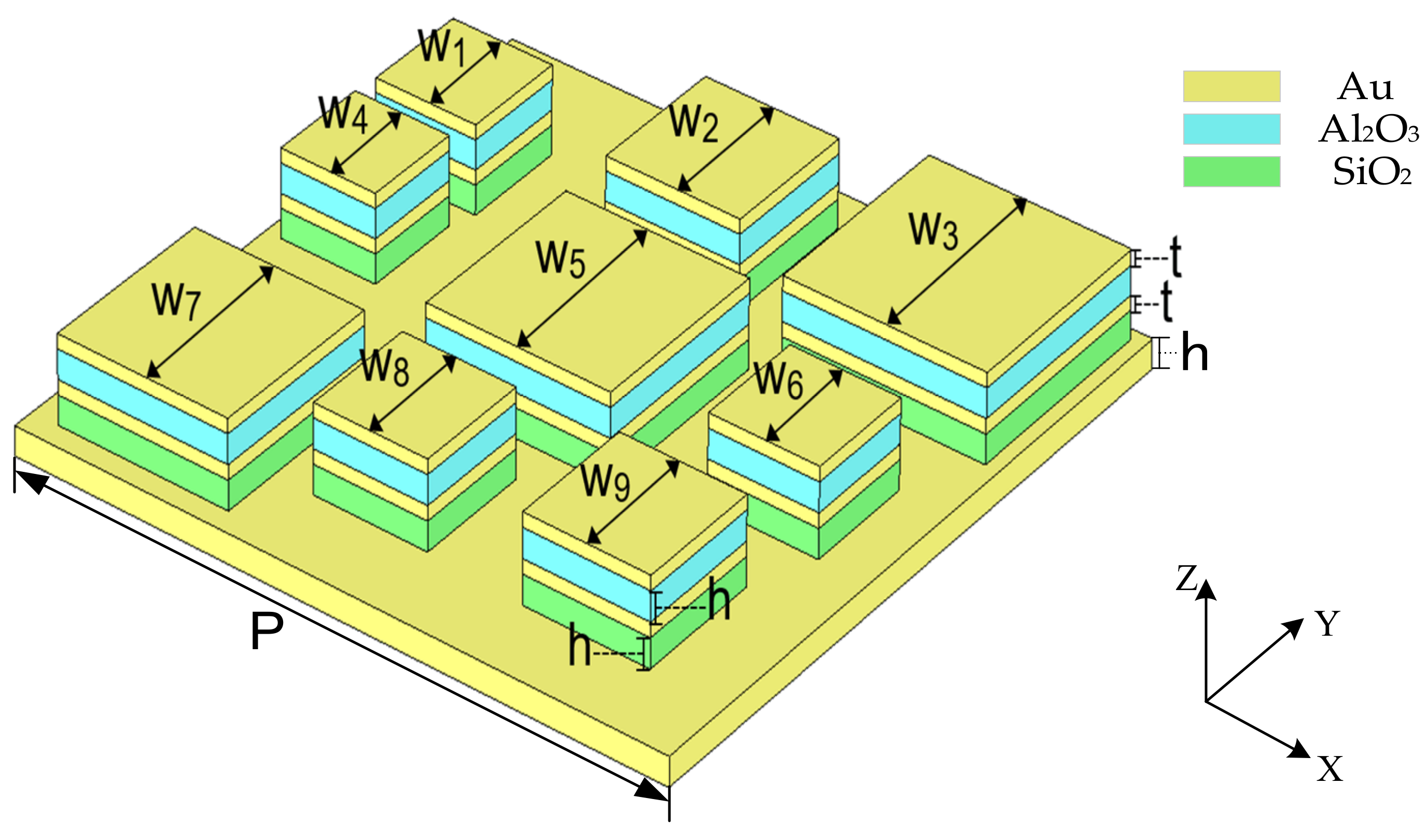


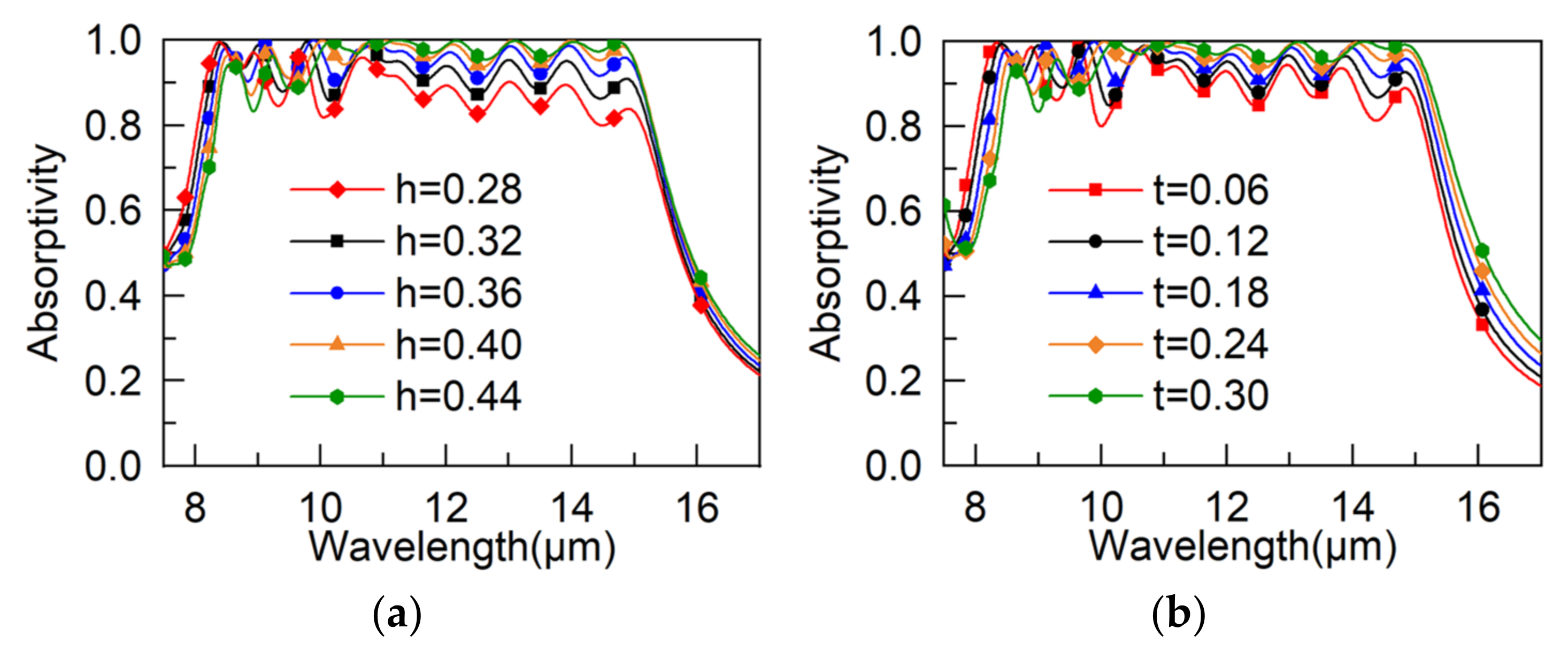
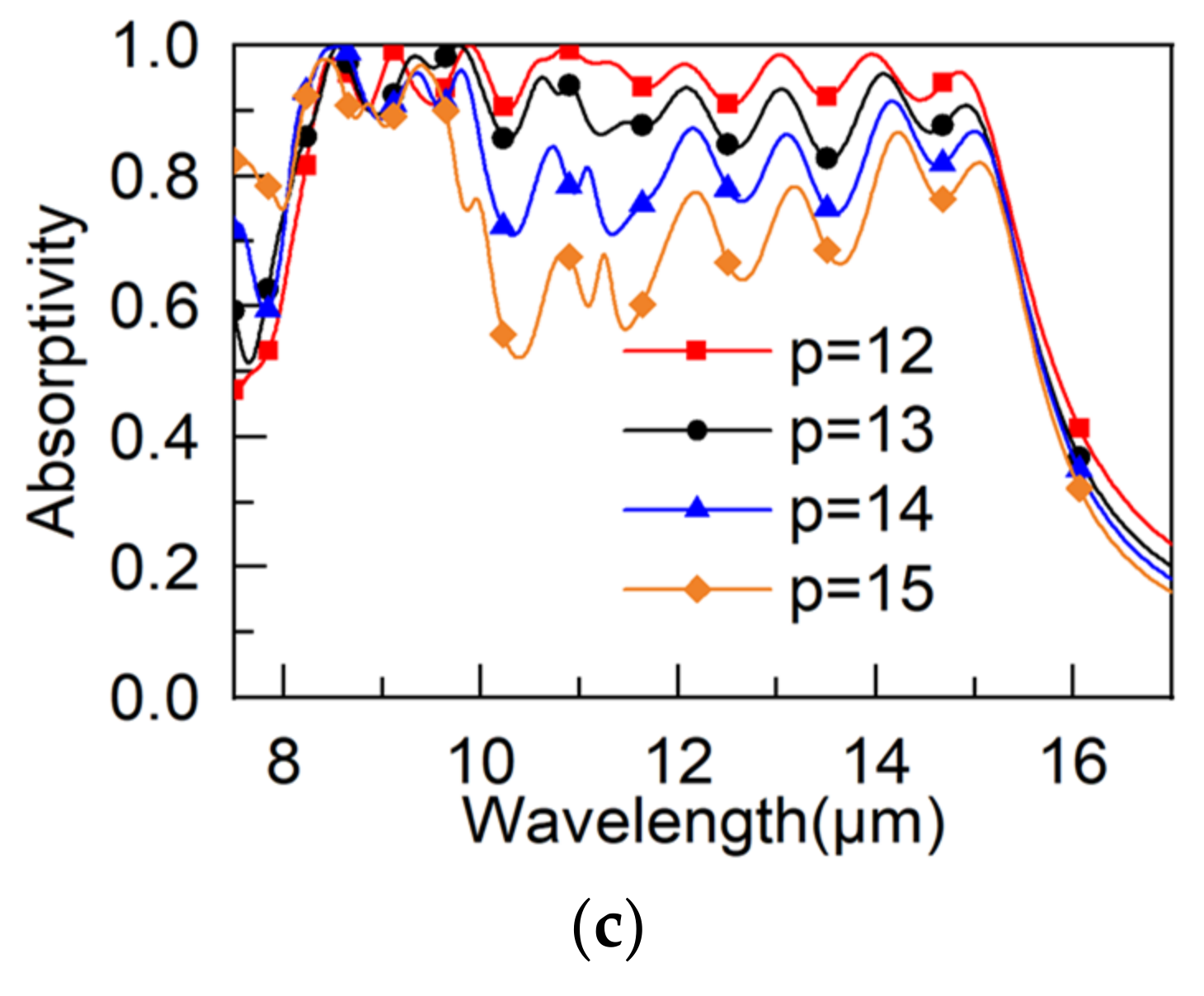
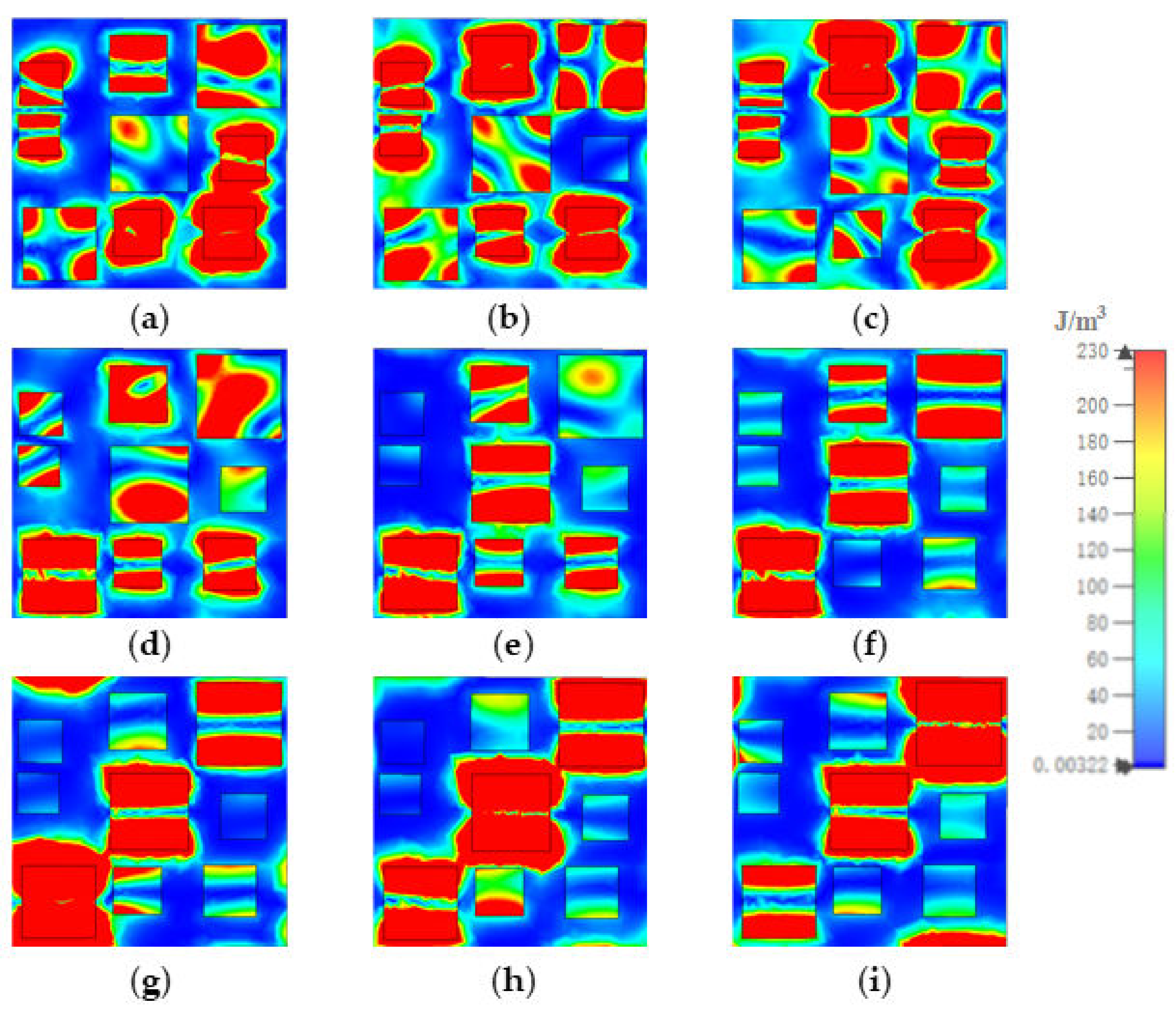
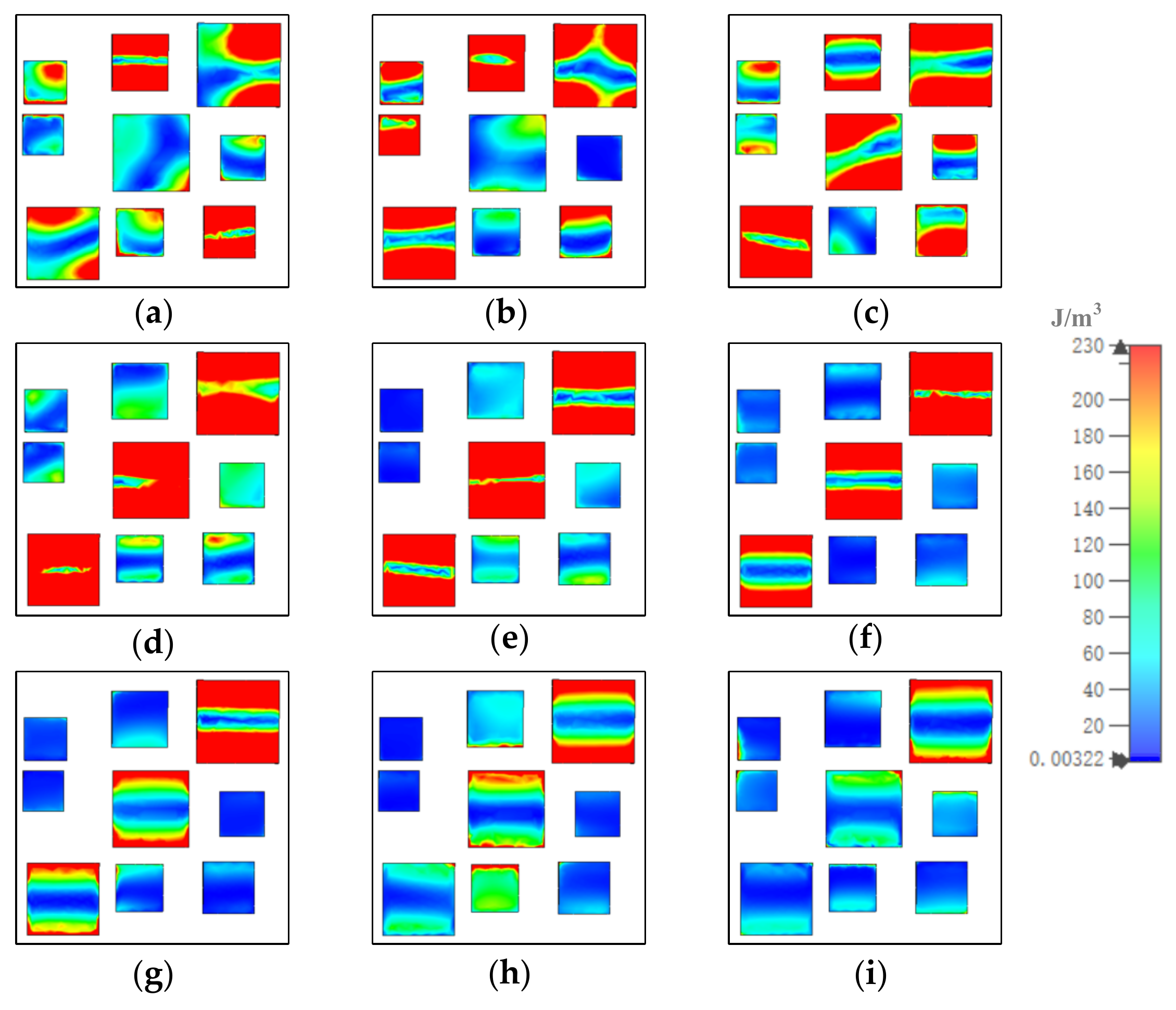
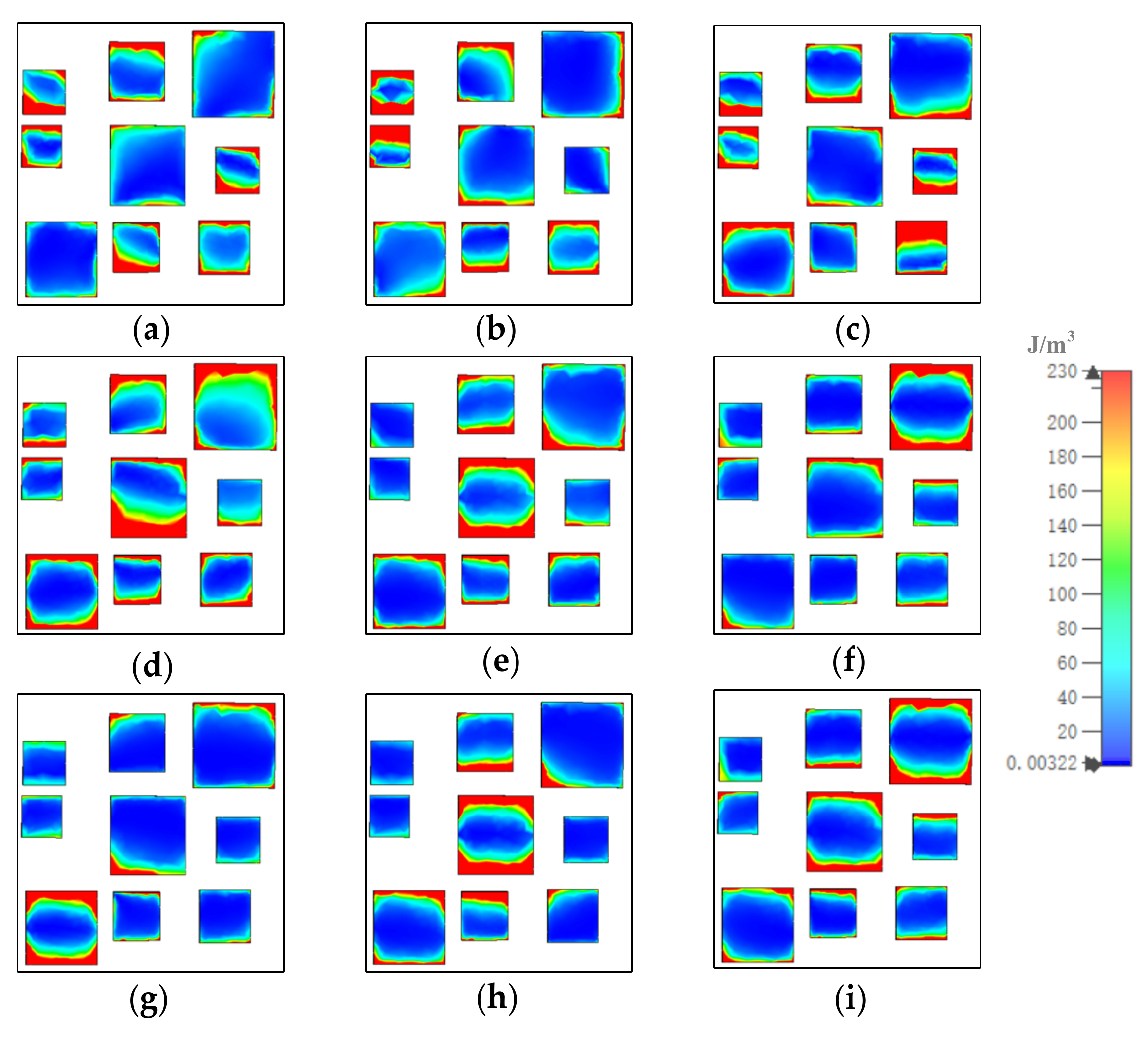
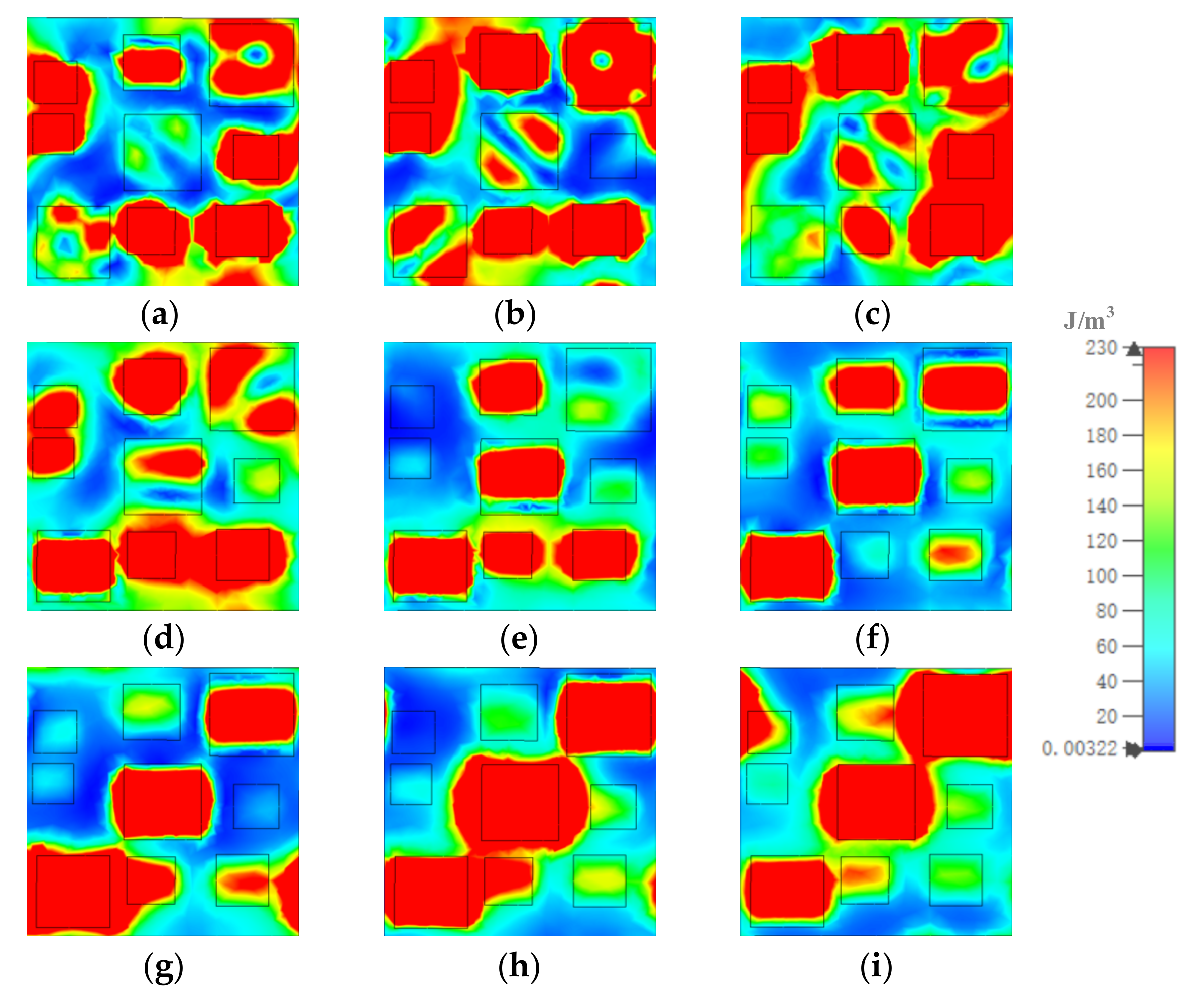
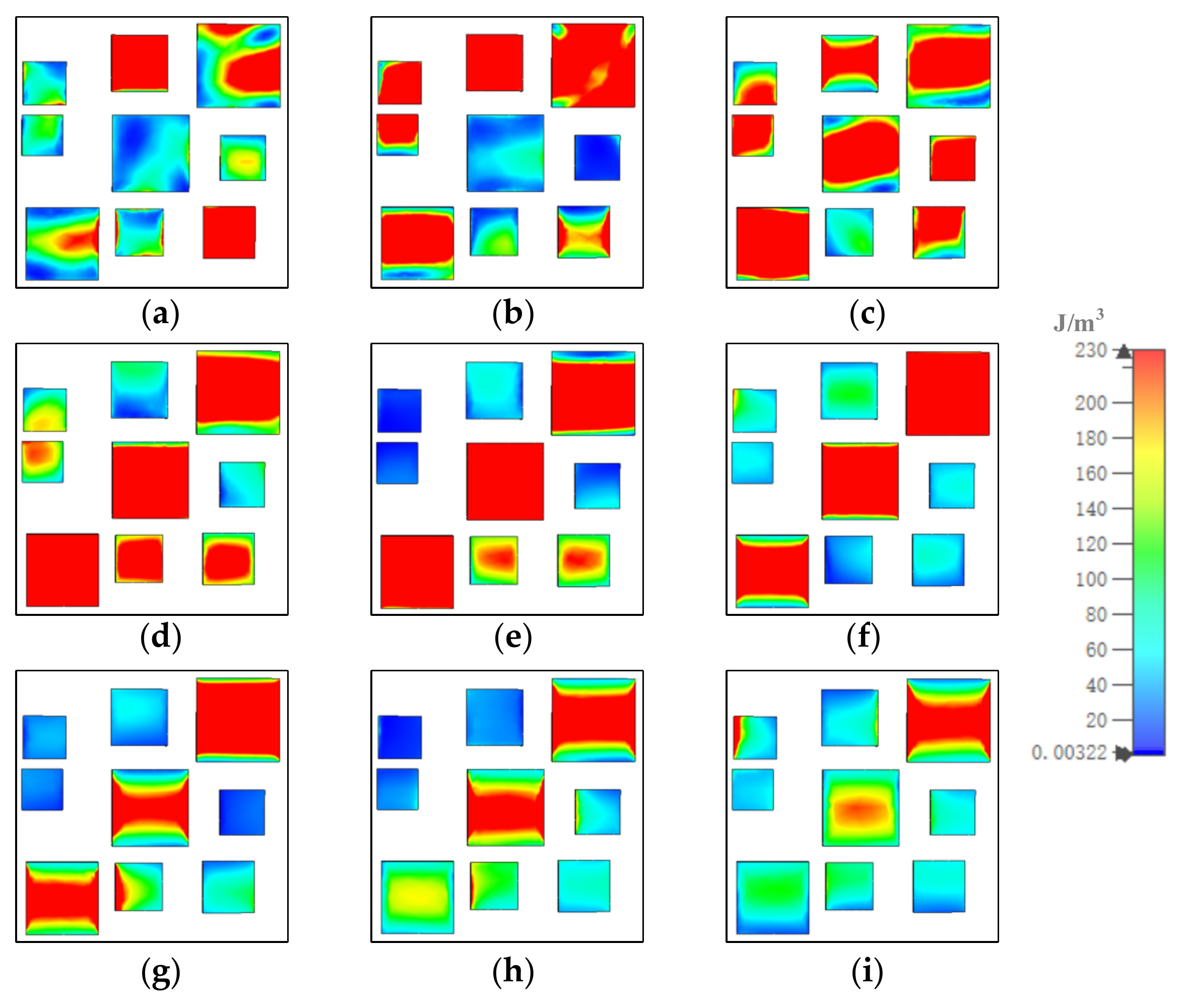
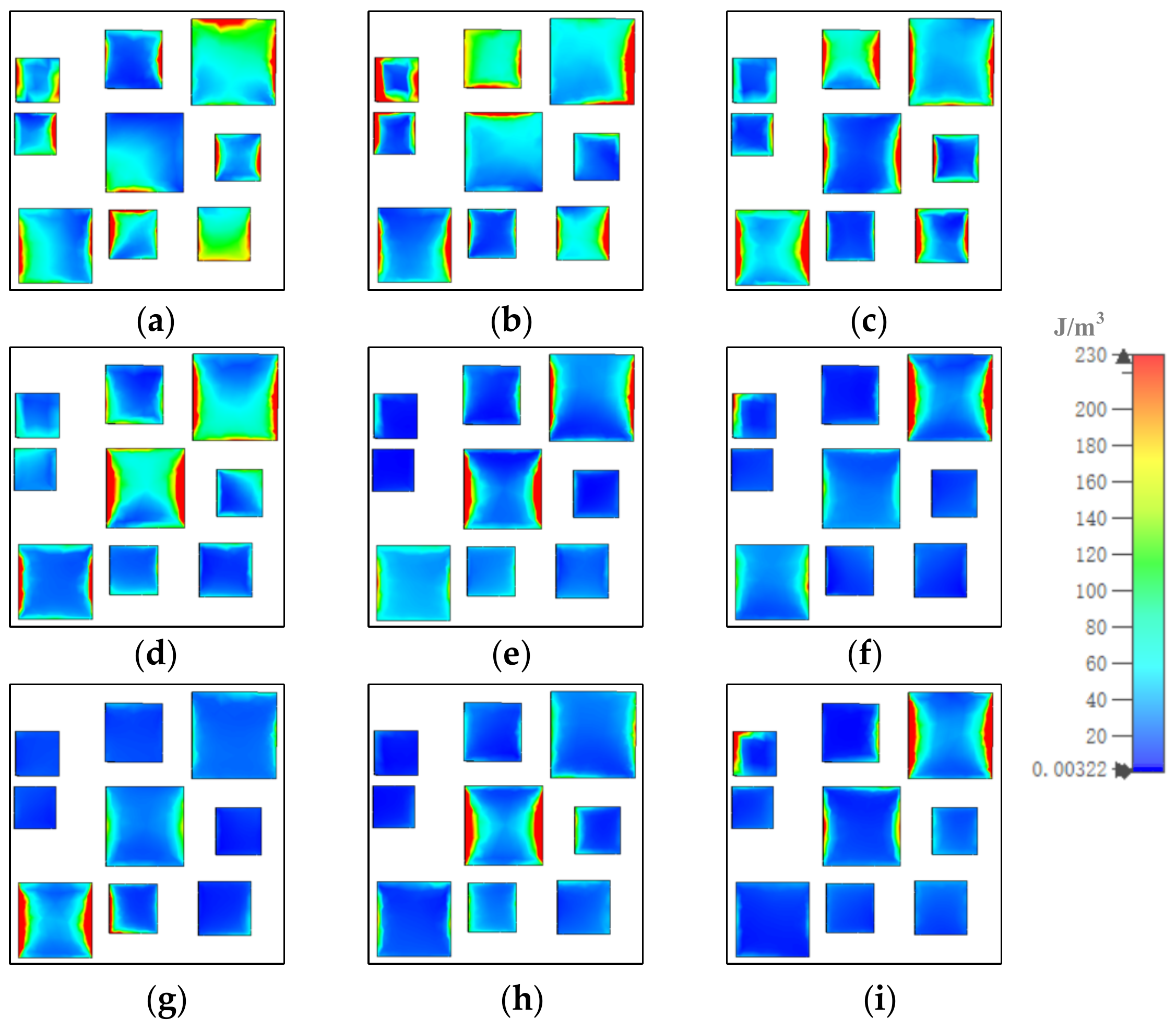
| Parameter | Size (μm) | Parameter | Size (μm) |
|---|---|---|---|
| P | 12 | w4 | 1.8 |
| t | 0.18 | w5 | 3.4 |
| h | 0.36 | w6 | 2.0 |
| w1 | 1.9 | w7 | 3.2 |
| w2 | 2.5 | w8 | 2.1 |
| w3 | 3.7 | w9 | 2.3 |
Publisher’s Note: MDPI stays neutral with regard to jurisdictional claims in published maps and institutional affiliations. |
© 2022 by the authors. Licensee MDPI, Basel, Switzerland. This article is an open access article distributed under the terms and conditions of the Creative Commons Attribution (CC BY) license (https://creativecommons.org/licenses/by/4.0/).
Share and Cite
Huang, X.; Zhou, Z.; Cao, M.; Li, R.; Sun, C.; Li, X. Ultra-Broadband Mid-Infrared Metamaterial Absorber Based on Multi-Sized Resonators. Materials 2022, 15, 5411. https://doi.org/10.3390/ma15155411
Huang X, Zhou Z, Cao M, Li R, Sun C, Li X. Ultra-Broadband Mid-Infrared Metamaterial Absorber Based on Multi-Sized Resonators. Materials. 2022; 15(15):5411. https://doi.org/10.3390/ma15155411
Chicago/Turabian StyleHuang, Xiaojun, Ziliang Zhou, Miao Cao, Rong Li, Cuizhen Sun, and Xiaoyan Li. 2022. "Ultra-Broadband Mid-Infrared Metamaterial Absorber Based on Multi-Sized Resonators" Materials 15, no. 15: 5411. https://doi.org/10.3390/ma15155411
APA StyleHuang, X., Zhou, Z., Cao, M., Li, R., Sun, C., & Li, X. (2022). Ultra-Broadband Mid-Infrared Metamaterial Absorber Based on Multi-Sized Resonators. Materials, 15(15), 5411. https://doi.org/10.3390/ma15155411






